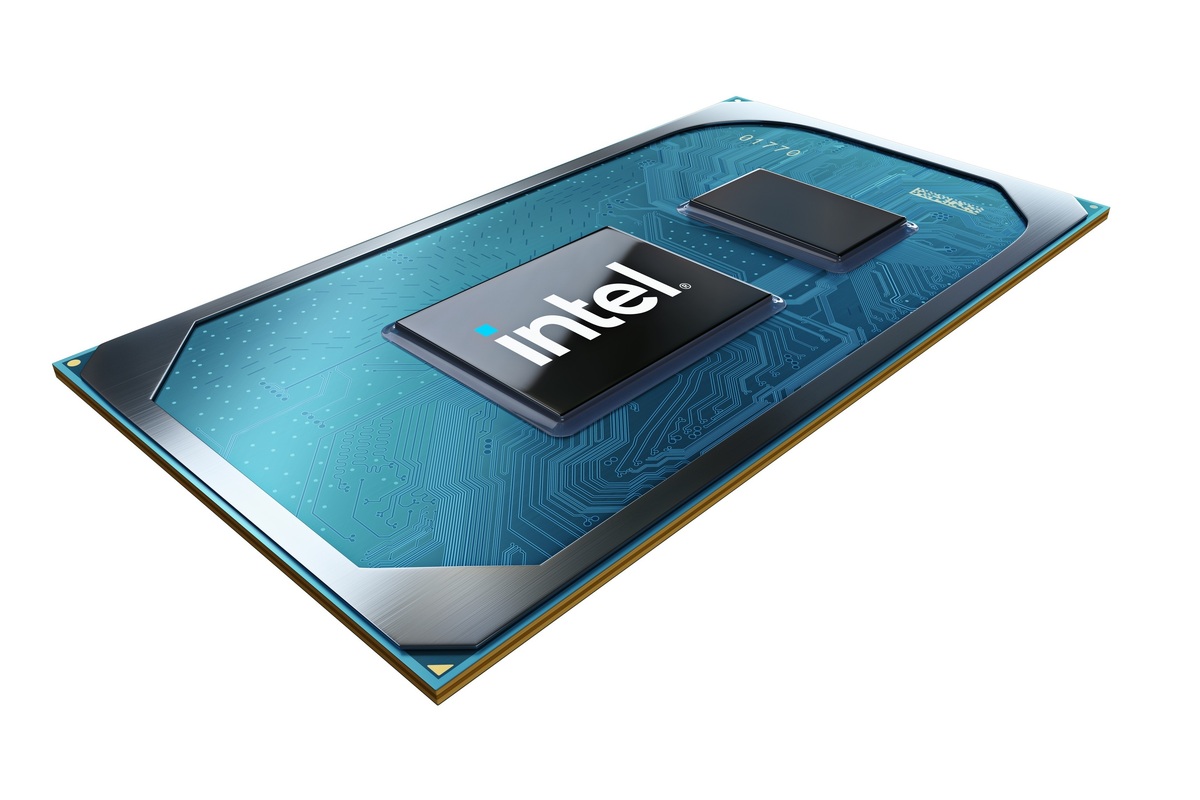[responsivevoice_button rate=”1″ pitch=”1.2″ volume=”0.8″ voice=”US English Female” buttontext=”Story in Audio”]
Intel 11th-gen Core i7-1185G7 Tiger Lake Preview: It’s (mostly) faster than Ryzen
It wouldn’t be a stretch to say that Intel’s 11th-gen Tiger Lake is perhaps the most important laptop CPU launch for the company. While previous generations suffered no real competition from AMD, Tiger Lake enters the ring facing a legitimate foe: Ryzen 4000.
You can read up on AMD’s game-changing Ryzen 9 4800HS, or its recently surfaced and equally impressive Ryzen 7 4800U for mainstream laptops. And yes, that was a budget Acer beating a Core i7 MacBook senseless.
Today, however, is about whether Intel’s new 11th-gen 10nm Tiger Lake chip and its SuperFin transistors and Iris Xe graphics have what it takes to keep AMD at bay. Intel gave us the opportunity to take an 11th-gen Tiger Lake reference laptop (a sample design, not a retail product) for a spin.
Keep reading to see how it fares in a grueling roster of benchmarks. And if you want to skip to a specific section, please use the links at left or below:
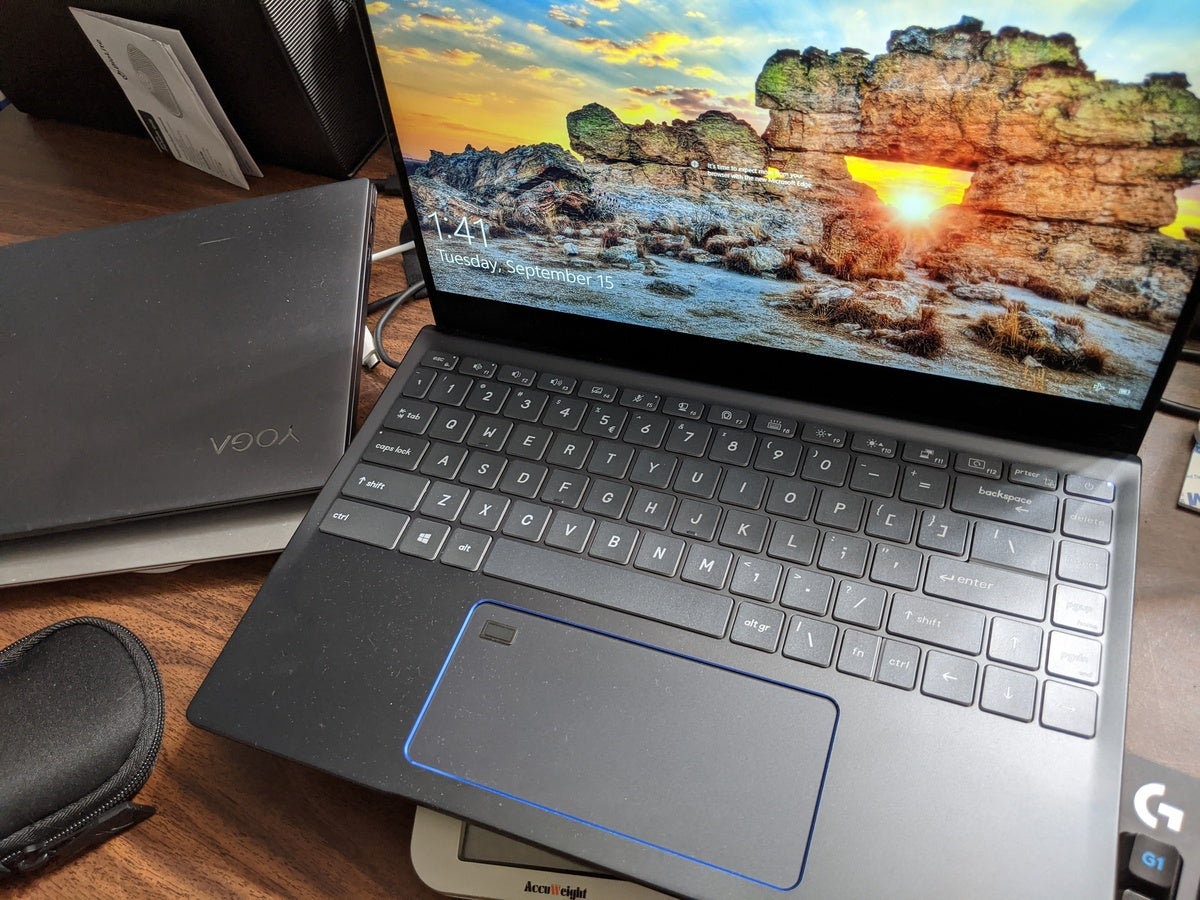 Gordon Mah Ung
Gordon Mah UngIntel gave us full access to a reference laptop with an Intel 11th gen Core i7-1185G7 inside of it.
A preview with conditions
For this performance preview, Intel loaned us the laptop with a few strings attached. We say few, because there were a couple more for which we had a nerds’ agreement not to test.
The main one was battery life. Intel said the reference laptop was still pretty rough in tuning, and the company didn’t think it would be representative of battery life from a final unit. The trickle-down of that meant we also couldn’t report on, say, how much power it used while on battery. Although battery power is extremely important in a laptop, we felt it was a fair request.
The second request was not to show a photo of the insides of the laptop. We are allowed to show you the bottom of it, and since we have seen the inside, we’ll sketch out where the components are.
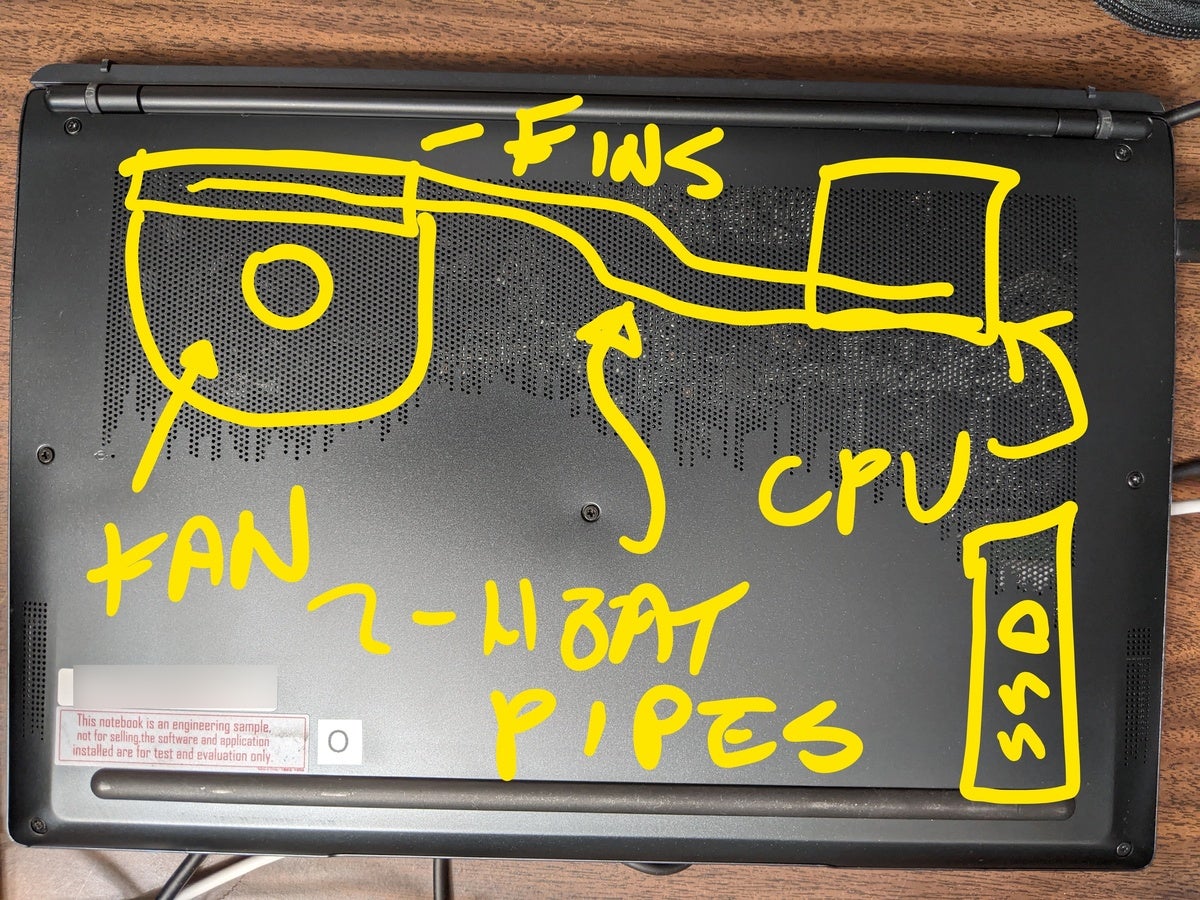 Gordon Mah Ung
Gordon Mah UngThe Intel Tiger Lake reference laptop we used featured two heat pipes and a single fan and fin stack.
The laptop itself is built on a fairly light 14-inch body. In weight, it’s actually very close to the 10th-gen Dell XPS 13 2-in-1 7390 and slightly lighter than Lenovo’s 14-inch, Ryzen 7-based Slim 7. The laptop is actually capable of taking discrete graphics and features two heat pipes routed to a single fan and fin stack. The laptop features a Core i7-1185G7 Tiger Lake CPU with 16GB of LPDDR4X/4266 RAM and a 1TB NVMe SSD. There screen is a 1920×1080 panel without touch.
We can guess who made it, but we’ll stick to our agreement and refer to it as a reference system. It’s pretty easy, however, to search for 14-inch laptops with Comet Lake U and discrete GeForce GTX graphics if you want to see it in its branded trim.
Other than those agreements, we were free to run what we wanted. Intel did provide its RUGs, or “Representative Usage Guides,” which are canned tests built on practical applications.
While we think there is value in them, we skipped running Intel’s own tests, because it invites too much hand-wringing from worrywarts. That doesn’t mean we skipped what Intel tested though, which you’ll see below.
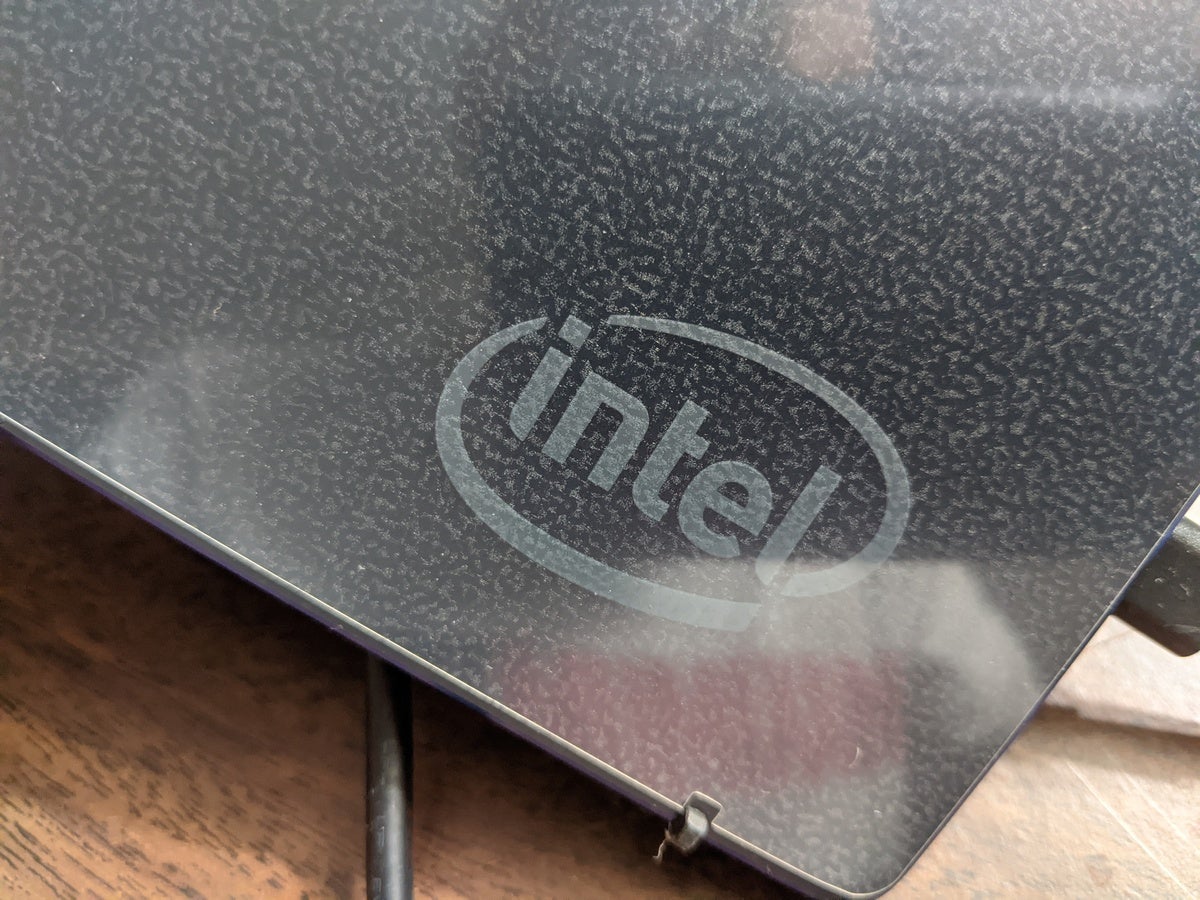 Gordon Mah Ung
Gordon Mah UngThe Intel reference laptop does feature an Intel logo on the lid.
How we tested
For this performance preview, we compared the Core i7-1185G7 and Iris Xe graphics to three contemporaries: “Comet Lake U” in a Dell XPS 13 7390 with 6-core Core i7-10710U and HD graphics, “Ice Lake” in a Dell XPS 13 2-in-1 7390 with 4-core Core i7-1065G7 and Iris Plus graphics, and a “Renoir” 8-core Ryzen 7 4800U in a Lenovo Slim 7 with Radeon graphics. All of the laptops were running updated display drivers, the latest UEFI/BIOSes, and Windows 10 2004.
All three were also run on their highest performance settings. For the Dells that’s “Ultra Performance,” and for the Lenovo that’s “Extreme Performance.” Looking at what the laptops reported, the 14nm Comet Lake U told HWInfo it had a PL1 power limit of 22 watts. You can think of power limits like the gears of a car, and PL1 is very much like a second or third gear. A laptop will first hit PL2 for just a few milliseconds and then perhaps push PL1 for 28 seconds, or as long as it can sustain a certain thermal and power threshold. The XPS 13 7390’s 6-core CPU shows the weakness of the hot 14nm chip with its 22-watt PL1. The 10nm 10th-gen Ice Lake in the XPS 13 2-in-1 7390 says it can hit 46 watts in PL1 for 28 seconds. We actually don’t think it’s 46 watts—we suspect HWInfo is reading the laptop’s Adaptix technology. Adaptix uses machine learning to try to hold higher boost clocks. For the Lenovo Slim 7, HWInfo reported a PL1 of 38.5 watts.
All of the TDP ratings of retail laptops are based on tuning and optimization by the OEM. For the reference laptop, Intel lets us pick from three TDPs using the Windows power slider: 15 watts, 28 watts, and 28 watts with Dynamic Tuning. Dynamic Tuning is part of Intel’s suite of tools to coax higher clock speeds out of a chip based on the workload. For what it’s worth, HWInfo identified this as a PL1 of 36 watts. The last knob we had available to us was the laptop’s own High Performance setting, which, when set, raised the PL1 to 41 watts.
 Gordon Mah Ung
Gordon Mah UngCan you figure out who built Intel’s reference laptop?
The limitations of this preview
While this preview will show what a Tiger Lake is capable of, there are limits to it. That’s because PC OEM typically tune laptops based on what they wrap around the CPU. While we can show you how it performs at a hard-locked 15 watts (28 watts with Dynamic Tuning enabled), it’s hard to say what a particular laptop maker will decide for its design. In short, your mileage may vary in an actual production laptop.
Still, the value is you can potentially see the upper and lower limits of how well an 11th-gen Tiger Lake performs. In a design that pushes Tiger Lake hard, such as MSI’s Stealth 15M, it might even be faster.
11th-gen graphics performance: Intel in front!?
We’ll kick this off in the area that’s truly the most shocking: Intel’s leading graphics performance. And yes, if you see a snowman in summer, it’s because for the first time in forever, Intel’s graphics performance isn’t embarrassing.
UL’s 3DMark Sky Diver is a synthetic, but very repeatable graphics test that’s made to measure fairly moderate gaming loads. We’ll first show you 3DMark’s Sky Diver graphics result, which makes it a nearly pure graphics test.
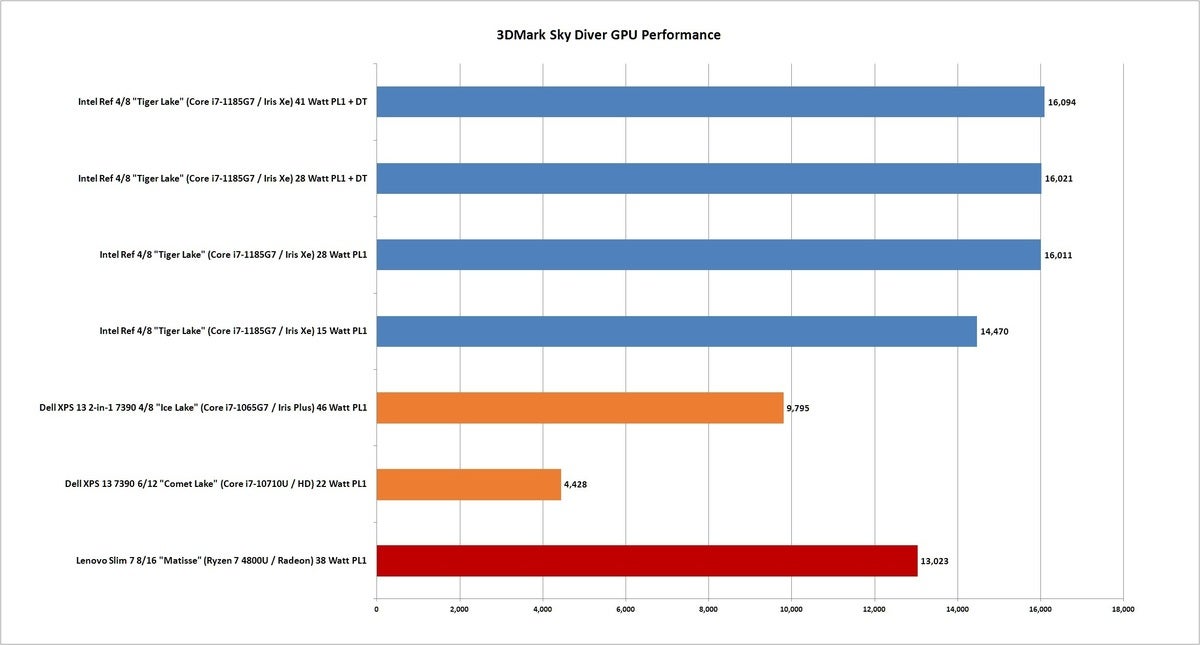 IDG
IDG3DMark’s Time Spy test is a little more strenuous. It’s a DX12 test that UL said actually loads up a GPU five times more than 3DMark’s FireStrike. What’s amazing is the results almost look the same as Sky Diver.
With 11th-gen Tiger Lake set to its higher wattage, it’s almost 300 percent faster than the ancient Intel HD graphics in the 10th-gen Comet Lake U chip, and about 90 percent faster than the 10th-gen Ice Lake U chip. More importantly for Intel is its position ahead of Ryzen 7 4800U. Even with its 8 CU’s of Radeon graphics cores and LPDDR4X/4266 inside the AMD laptop, the Core i7-1185G7 is still a healthy 35 percent faster than its nemesis.
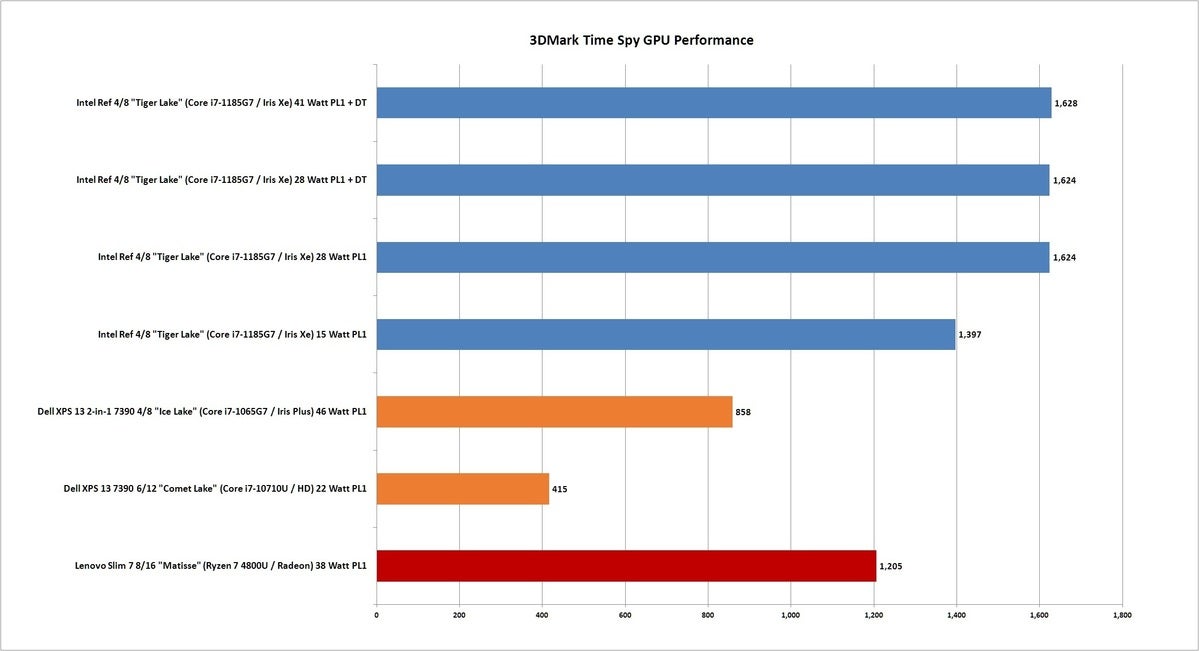 IDG
IDGWe could show you results from other 3DMark tests, but we’ve had enough of the synthetics. And rather than use games you’d normally run on laptops with integrated graphics, such as Rocket League or other eSports titles, we reached for games a little harsher.
The first is Far Cry New Dawn, which we ran at 1920×1080 resolution with the game set to Normal. The performance is again impressive for Intel’s Iris Xe: It comes in 360 percent faster than Intel HD, 100 percent faster than Ice Lake’s Iris Plus, and 33 percent faster than Ryzen 7 4800U’s Radeon.
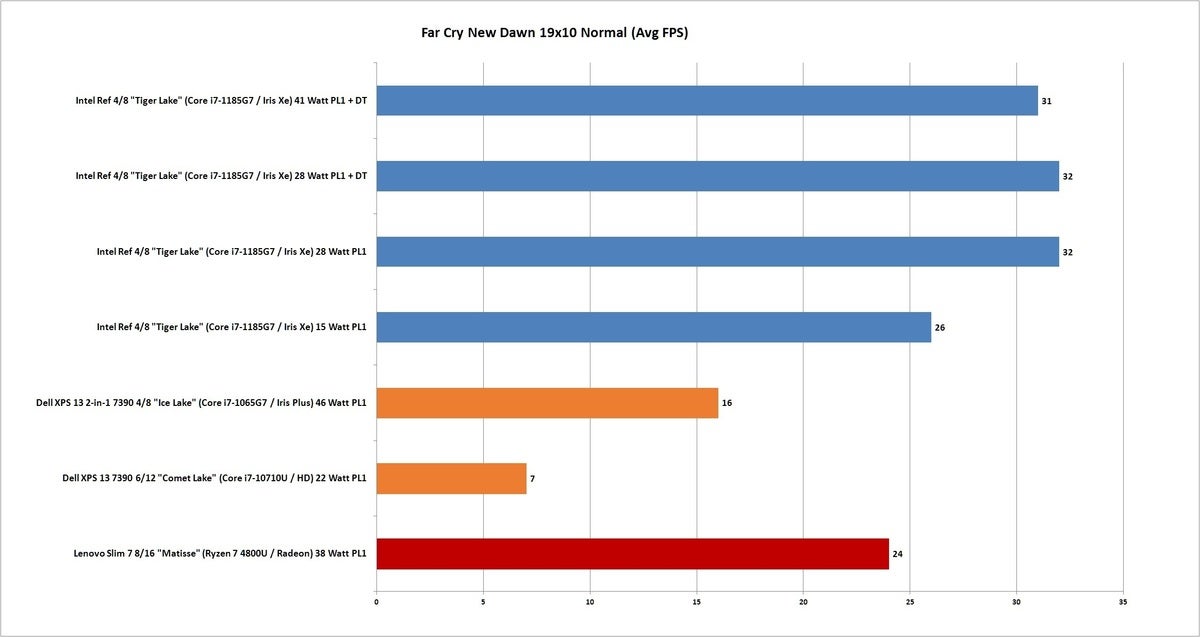 IDG
IDGThe Far Cry series has typically been slower on Ryzen desktop CPUs, so we also looked at performance on a game friendlier to AMD: Deus Ex Mankind Divided. This game was one the first that was patched and recommended by AMD in the rollout of the original Ryzen desktop chip.
For this showdown, we run Deus Ex at 1920×1080 with the game at its medium preset. The Tiger Lake result is about 300 percent more performance than Intel HD, 109 percent faster than 10th-gen Ice Lake’s Iris Plus, and about 36 percent faster than Ryzen 7 4800U.
 IDG
IDGMoving to Metro Exodus at 1920×1080 with the normal preset, we find the 11th-gen Core i71185G7 and its Iris Xe graphics about 244 percent faster than Intel HD, about 93 percent faster than 10th-gen Ice Lake Iris Plus and 26 percent faster than Ryzen 7 4800U.
 IDG
IDGThe last game we’ll show you is Shadows of the Tomb Raider, also set to 1920×1080 and Medium. The game is pretty tough on the laptops—both the 10th-gen Core i7-1065G7 and 10th-gen Core i7-10710U failed to complete running the benchmark. Ryzen 7 4800U did manage to close up with the Core i7-1165G7, but it still sees the Iris Xe about 16 percent faster in the run. Winner: Tiger Lake.
 IDG
IDGIn no game did we see the 11th-gen Tiger Lake and Xe chip lose. We also tried Red Dead Redemption 2, where, thanks to Tiger Lake’s immature drivers, the game crashed during the benchmark. That probably sounds bad, but Intel said it knows about the issue and will soon deploy a new driver to correct it. For what it’s worth, the Ryzen 7 4800U gave us about 8.5 fps in RDR2, while to my eye, the benchmark run on Xe looked far smoother—we’d guess in the mid- to high teens in performance.
Yes, none of these are a GeForce RTX 3090—but the fact that you can even entertain playing slightly older AAA games on a laptop with Intel integrated graphics is unheard of. Crank down the resolution and tune some game settings, and we think Xe could be as revolutionary in laptop gaming as, well, AMD’s Ryzen chip was.
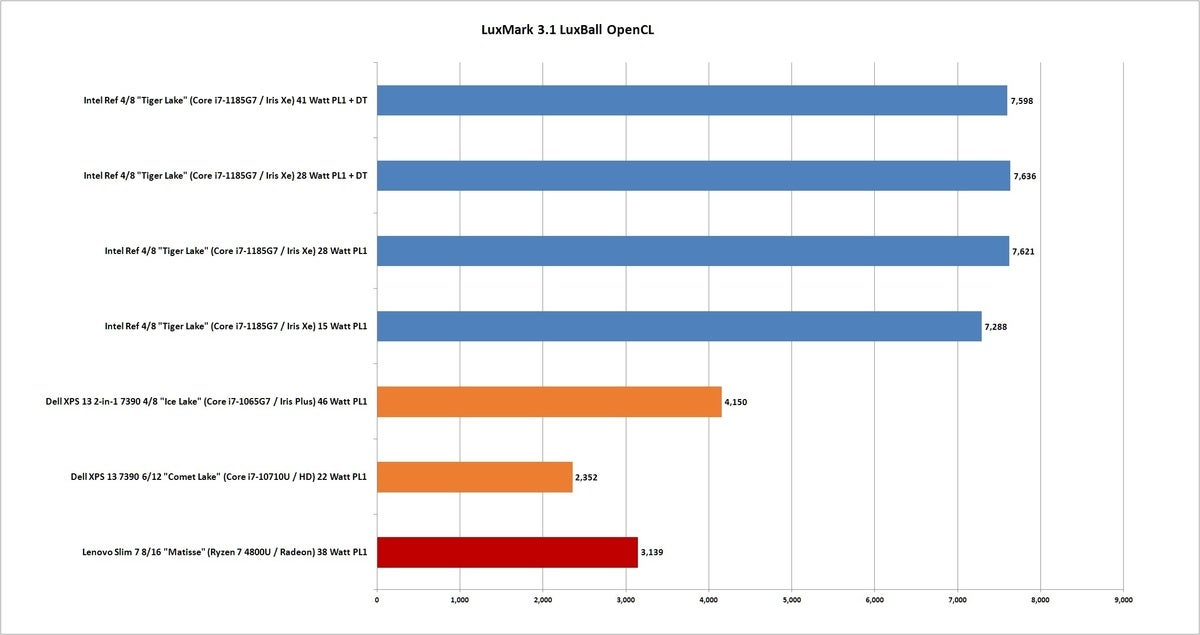 IDG
IDGAlthough the OpenCL graphics engine seems to be rapidly losing steam, we did want to see where the Xe falls, so we used LuxMark 3.1 and LuxBall. It’s again very impressive, with Iris Xe about 225 percent faster than Intel HD graphics, 84 percent faster than Iris Plus and 143 percent faster than Radeon.
The last graphics-focused test we wanted to run was the free HandBrake utility, using the CPU’s Quick Sync engine. Intel said the results wouldn’t currently represent what Tiger Lake can do. We suspect that means Tiger Lake would lose, as we’ve tested AMD’s VCE against Ice Lake’s Quick Sync performance and Ryzen was slightly faster. Still, there’s not much of a point right now.
We’ll close out with one advanced media engine test: Microsoft’s free Video Editor built into Windows 10, which leverages both Quick Sync and VCE. We had previously tried to use it when Ryzen first came out, but the hardware acceleration didn’t work on AMD CPUs. AMD has since worked with Microsoft to fix it. For this simple test, we take the Tears of Steel 4K video, throw on a sepia filter, and export it to 1080p with hardware acceleration enabled.
While all the chips are decently fast, Ryzen actually finishes last, even losing to the 10th-gen Comet Lake U chip. 11th-gen Tiger Lake itself comes in second place, with the 10th-gen Ice Lake crossing the finish line first.
 IDG
IDGKeep reading for CPU performance and more.















